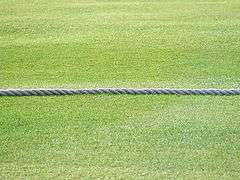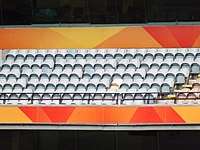Boundary (cricket)
In cricket, the boundary is the perimeter of a playing field. It is also the term given to a scoring shot where the ball is hit to, or beyond, that perimeter.
Edge of the field
The boundary is the edge of the playing field, or the physical object (often a rope) marking the edge of the field. In low-level matches, a series of plastic cones are sometimes used. Since the early 2000s, the boundaries at professional matches are often a series of padded cushions carrying sponsors' logos strung along a rope. If it is accidentally moved during play (such as by a fielder sliding into the rope in an attempt to stop the ball) the boundary is considered to remain at the point where that object first stood.

When the cricket ball is inside the boundary, it is live. When the ball is touching the boundary, grounded beyond the boundary, or being touched by a fielder who is himself either touching the boundary or grounded beyond it, it is dead and the batting side usually scores 4 or 6 runs for hitting the ball over the boundary. Because of this rule, fielders near the boundary attempting to intercept the ball while running or diving often flick the ball back in to the field of play rather than pick it up directly, because their momentum could carry them beyond the rope while holding the ball. They then return to the field to pick the ball up and throw it back to the bowler.
A law change in 2010 declared that a fielder could not jump from behind the boundary and, while airborne, parry the ball back on to the field.[1][2]
Scoring runs
A boundary is the scoring of four or six runs from a single delivery with the ball reaching or crossing the boundary of the playing field. Occasionally there is an erroneous use of the term boundary as a synonym for a "four". For example, sometimes commentators say such as "There were seven boundaries and three sixes in the innings." The correct terminology would be "There were ten boundaries in the innings of which seven were fours and three were sixes."
Four runs are scored if the ball bounces before touching or going over the edge of the field and six runs if it does not bounce before passing over the boundary in the air. These events are known as a four or a six respectively. When this happens the runs are automatically added to the batsman's and his team's score and the ball becomes dead. If the ball did not touch the bat or a hand holding the bat, four runs are scored as the relevant type of extra instead; six runs cannot be scored as extras, even if the ball clears the boundary, which is in any case extremely unlikely. Prior to 1910, six runs were only awarded for hits out of the ground,[3] with five runs awarded for clearing the boundary.[4]
Four runs (or more) can also be scored by hitting the ball into the outfield and running between the wickets. Four runs scored in this way is referred to as an "all run four" and is not counted as a boundary.
Four runs are scored as overthrows if a fielder gathers the ball and then throws it so that no other fielder can gather it before it reaches the boundary. In this case, the batsman who hit the ball scores however many runs the batsmen had run up to that time, plus four additional runs, and it is counted as a boundary. If the ball has not come off the bat or hand holding the bat, then the runs are classified as 'extras' and are added to the team's score but not to the score of any individual batsman.

The scoring of a four or six by a good aggressive shot displays a certain amount of mastery by the batsman over the bowler, and is usually greeted by applause from the spectators. Fours resulting from an edged stroke, or from a shot that did not come off as the batsman intended, are considered bad luck to the bowler. As a batsman plays himself in and becomes more confident as his innings progresses, the proportion of his runs scored in boundaries often rises.
An average first-class match usually sees between 50 and 150 boundary fours. Sixes are less common, and usually fewer than 10 (and sometimes none) will be scored in the course of a match (especially a Test match).
Records
Sixes

The record for most sixes in a Test match innings is 12, which was achieved by Pakistani all-rounder Wasim Akram during an innings of 257 not out against Zimbabwe in October 1996 at Sheikhupura. The One Day International record for most sixes hit in an innings is held by Eoin Morgan, who hit 17 sixes against Afghanistan at Old Trafford on 18 June 2019 in his innings of 148 off 71 balls. Brendon McCullum currently holds the record for most sixes in a Test career with 107.[5] Shahid Afridi holds the record for most sixes in an ODI career (351 in 398 matches, 369 innings, on his retirement).[6]

The record for the most sixes in a Test match is 27, which occurred during a 2006 Test match between Pakistan and India at the Iqbal Stadium in Faisalabad. In their first innings, Pakistan hit eleven sixes. India hit nine in their first innings. Pakistan hit seven more sixes in their second innings.
The record for most sixes in a One Day International is 46, which was achieved in a match between West Indies and England at St George’s on 27 February 2019. England hit 24 and West Indies hit 22 sixes. The equivalent record in Twenty20 Internationals was set on the AMI Stadium, 24 sixes were hit during the Twenty20 International match between India and New Zealand on 25 February 2009.
In 2012, during the First Test against Bangladesh in Dhaka, West Indies cricketer Chris Gayle became the first player to hit a six off the first ball in a Test cricket match.[7]
Six sixes in an over
As of January 2020, feat has occurred seven times in top level domestic or international cricket:[8]
On 31 August 1968, Garfield Sobers became the first man to hit six sixes off a single six-ball over in first-class cricket.[9] The over was bowled by Malcolm Nash in Nottinghamshire's first innings against Glamorgan at St Helen's in Swansea. Nash was a seam bowler but decided to try his arm at spin bowling.[10] This achievement was caught on film.[11]
On 10 January 1985,[12] Ravi Shastri equaled Garry Sobers's record of hitting six sixes in an over in first class cricket.
On 16 March 2007, in a match between South Africa and the Netherlands at the 2007 Cricket World Cup, Herschelle Gibbs became the first person to hit six sixes off an over in a One Day International match. The over was bowled by Dutch leg-spinner Daan van Bunge.[13]
On 19 September 2007, during a match between England and India in the inaugural T20 World Cup, Yuvraj Singh became the first batsman to hit six sixes in an over in a T20 International, in an over bowled by Stuart Broad.
On 24 April 2013, Jordan Clark hit six sixes for Lancashire 2nd XI off Yorkshire 2nd XI's Gurman Randhawa at Scarborough. [14]
On 23 July 2017, Worcestershire's Ross Whiteley hit six sixes off six legal deliveries plus one wide to take the total number of runs in that over to 37 off bowler Karl Carver of Yorkshire at Headingley during a NatWest T20 Blast match.[15]
In October 2018 Afghan player Hazratullah Zazai hit six sixes in an over, becoming the third ever batsman to do so in a Twenty20 match.[16]
On 5 January 2020, in the 2019–20 Super Smash match between Canterbury and Northern Districts, Leo Carter hit six sixes in one over off the bowling of Anton Devcich.[17]
References
- "Explanation of the changes between the 3rd Edition and 4th Edition of the 2000 Code of the Laws of Cricket" (PDF).
- "October 2010 Laws of cricket changes – Ball over the boundary". Lords Cricket Ground. Retrieved 14 November 2013.
- "Ask Steven", 23 January 2006 Retrieved 7 July 2011
- "Just not cricket". ESPN Cricinfo. Retrieved 14 January 2020.
- "Records – Test matches – Batting records – Most sixes in career – ESPN Cricinfo". Cricinfo.
- "Records – One-Day Internationals – Batting records – Most sixes in career – ESPN Cricinfo". Cricinfo.
- "West Indies' Chris Gayle creates Test history with opening six". BBC Sport. Retrieved 14 November 2012.
- Norris, Sam (24 May 2019). "The batsmen to have hit six sixes in an over". William Hill. Archived from the original on 18 October 2019. Retrieved 18 October 2019.
- Norman Preston. "Notes by the Editor". Wisden 1969. Cricinfo.
- "Glamorgan's Malcolm Nash, who Garry Sobers hit for six sixes in an over, dies at 74". ESPNcricinfo.com. 1 August 2019. Retrieved 18 October 2019.
- Garfield Sobers' six sixes in an over, Glam. v Notts., Swansea, 1968. YouTube.
- "10th January 1985: Ravi Shastri Hits-Six-Sixes-in-an-Over"
- "Gibbs matches Sobers in easy win". BBC Sport. 16 March 2007.
- {{cite web|url=https://www.bbc.co.uk/sport/cricket/22284876
- PA Sport (1 August 2018). "NatWest T20 Blast: Ross Whiteley hits six sixes in over for Worcester". Sky Sports. Retrieved 9 April 2018.
- "'Goodness me!' - Zazai hits six sixes in over". BBC Sport. 15 October 2018. Retrieved 18 October 2019.
- "Super Smash: Leo Carter smashes 6 sixes in an over as Kings stun Knights". Stuff. Retrieved 5 January 2020.